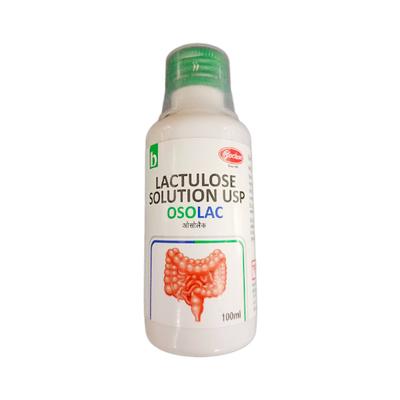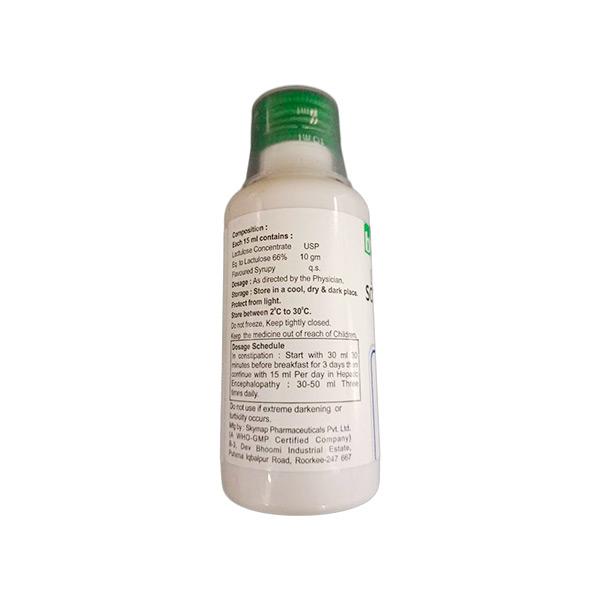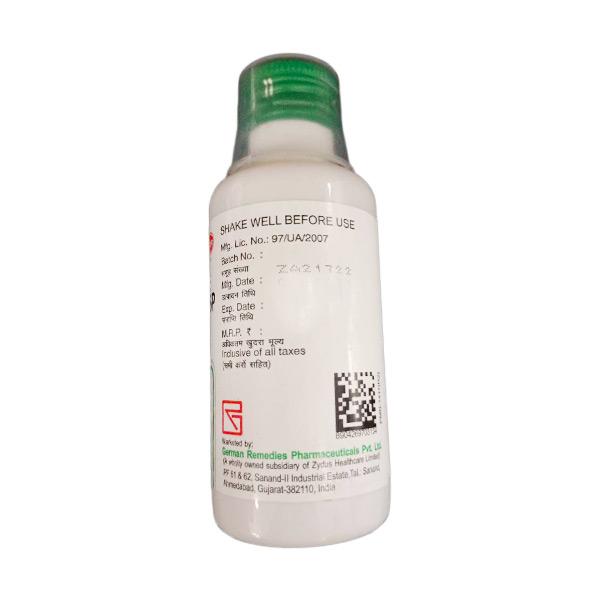

Netmeds First Membership
Quick Links
INTRODUCTION ABOUT OSOLAC SYRUP
OSOLAC SYRUP contains Lactulose which belongs to the group of medicines called Laxatives. It is used to manage constipation (infrequent bowel movements, hard and dry stools) and hepatic encephalopathy. Hepatic encephalopathy is a decline in brain function due to liver disease that causes symptoms like confusion, tremor and decreased level of consciousness, also it can lead to hepatic coma.
OSOLAC SYRUP is not recommended for use in patients with serious genetic disorder where you cannot digest galactose (galactosaemia), acute inflammatory bowel disease, blockage in bowels (apart from normal constipation), gastro-intestinal perforation or risk of perforation or stomach pain due to unknown cause. During management with OSOLAC SYRUP, you should drink enough fluids (about 6 - 8 glasses).
Before taking OSOLAC SYRUP, inform your doctor if you are lactose intolerant or have diabetes or roemheld syndrome. OSOLAC SYRUP should be used with caution in pregnant and breastfeeding women only if clearly advised by the doctor. OSOLAC SYRUP is usually not recommended for use in infants and smaller children but your child’s doctor may prescribe in certain circumstances.
It should be used with caution in elderly patients (aged 65 years and above) and your doctor may check your blood electrolytes when this medicine is taken for more than 6 months period or patients with bad general condition. The most common side effects of taking OSOLAC SYRUP are flatulence, stomach pain, nausea, vomiting, or diarrhea. Consult your doctor if any of the side effects worsen.
USES OF OSOLAC SYRUP
Manage:
- constipation
- hepatic encephalopathy
HOW OSOLAC SYRUP WORKS
OSOLAC SYRUP works by making the stool softer and easier to pass, by drawing more water into the bowel. It also reduces the amount of ammonia in the blood by removing the toxin from the bloodstream which helps to improve cognitive functions.
DIRECTIONS FOR USE
Take OSOLAC SYRUP as advised by your physician. Shake well before use. Use a measuring cup or spoon and swallow the medicine immediately, do not keep it in your mouth for long. You can mix this medicine with fruit juice or water. It is recommended that you drink plenty of fluids (6-8 glasses). Your doctor will decide the correct dose and duration for you according to your age, body weight and disease condition.
SIDE EFFECTS OF OSOLAC SYRUP
COMMON
- flatulence, stomach pain
- nausea, vomiting, diarrhea
UNCOMMON
- electrolyte imbalance because of diarrhea
Stop taking OSOLAC SYRUP and contact your doctor immediately if you experience any of the following side effects:
- abdominal swelling due to gas or bloating
HOW TO MANAGE SIDE EFFECTS
Bloating
Eat smaller and frequent meals and exercise regularly (like walking). Limit the intake of carbonated drinks. Avoid eating foods such as beans, lentils. If the symptom does not show improvement, consult your doctor.
Diarrhea
Drink lot of fluids such as water to keep yourself hydrated. Avoid eating high-fat or spicy foods. Do not take any medicine on your own to manage diarrhea without consulting your doctor.
Nausea And Vomiting
Take OSOLAC SYRUP with or just after meals. Stick to simple meals. Avoid eating oily, fried or spicy foods. Do not lie down or sleep immediately after eating. Consult your doctor if the symptom does not improve.
Stomach Pain
Try to rest and relax. Eat and drink slowly or try to eat smaller meals more frequently. Keep a heat pad on your stomach. If the stomach pain does not improve, consult your doctor.
WARNING & PRECAUTIONS
PREGNANCY
Monitoring requiredOSOLAC SYRUP should be used with caution in pregnant women only if considered clearly necessary. Consult your doctor before taking it.
BREASTFEEDING
Monitoring requiredOSOLAC SYRUP should be used with caution in breastfeeding women only if considered clearly necessary. Consult your doctor before taking it.
DRIVING AND USING MACHINES
Use with CautionOSOLAC SYRUP will not affect your ability to drive or use machines.
ALLERGY
ContraindicatedDo not take OSOLAC SYRUP if you are allergic to Lactulose or any other ingredients of this medicine.
USE IN PEDIATRICS
Use with CautionOSOLAC SYRUP should be used with caution in infant, baby or child (under 1 year of age to 18 years of age) only under the supervision of your doctor to manage constipation. Your child’s doctor may adjust the dose depending upon age. Consult child’s doctor for advice before administering OSOLAC SYRUP to your child.
USE IN GERIATRICS
Use with CautionOSOLAC SYRUP should be used with caution in elderly patients (aged 65 years and above). Your doctor may check your blood electrolytes when this medicine is taken for more than 6 months period. Consult your doctor before taking OSOLAC SYRUP
OTHERS
OSOLAC SYRUP is not recommended for use if you have:
- galactosaemia (serious genetic disorder where you cannot digest galactose)
- acute inflammatory bowel disease (like crohn's disease or ulcerative colitis)
- blockage in bowels (apart from normal constipation)
- gastrointestinal perforation or risk of perforation
- abdominal pain of unknown cause
- galactose or fructose intolerance, total lactase deficiency or glucose-galactose malabsorption
Before taking OSOLAC SYRUP, inform your doctor if you:
- are lactose intolerant (unable to digest milk sugar)
- have diabetes (high blood sugar)
- have Roemheld syndrome (a group of heart symptoms stimulated by gastrointestinal changes)
INTERACTIONS
A. Drug-Drug interactions:
Before taking OSOLAC SYRUP, inform your doctor if you are taking any of the following medicines:
- medicines used to manage fluid retention (Ex. chlorthalidone, hydrochlorothiazide)
- medicines used to manage inflammatory conditions (Ex. hydrocortisone, prednisolone)
- amphotericin B (used to manage serious fungal infections)
- medicines used to manage heart insufficiency (Ex. digitalis, digoxin)
- 5-aminosalicylic acid (5-ASA) such as mesalamine (used to manage inflammatory bowel disease such as crohn’s disease)
Overdosage:
If you or anyone else accidentally take too much of OSOLAC SYRUP, consult your doctor immediately or visit the nearby hospital. Overdosage symptoms of OSOLAC SYRUP are diarrhea, loss of electrolytes and abdominal pain.
SYNOPSIS
| Drug | : | Lactulose |
| Pharmacological Category | : | Osmotic purgative |
| Therapeutic Indication | : | Constipation, Hepatic encephalopathy |
| Dosage Forms | : | Chewable gummies, Enema, Liquid, Oral solution, Oral suspension, Syrup |
MORE INFORMATION
- Keep OSOLAC SYRUP out of reach of children
- Store at room temperature
FAQs ABOUT OSOLAC SYRUP
Q: Can OSOLAC SYRUP be given to infants?
A: OSOLAC SYRUP is usually not recommended for use in infants and smaller children as it can disturb the normal reflexes for passing stools. Your child’s doctor will decide the correct dose or select a suitable alternative management for your child. In special situation, your doctor may prescribe it for your baby, where they will supervise the management closely.
Q: Can OSOLAC SYRUP cause diarrhea?
A: OSOLAC SYRUP may cause diarrhea when you take higher than recommended dose of it. In such case, drink lot of fluids, such as water to keep yourself hydrated. Do not take any medicine on your own to manage diarrhea without consulting your doctor. If diarrhea does not improve, consult your doctor immediately.
Q: Can OSOLAC SYRUP be used during pregnancy?
A: OSOLAC SYRUP should be used with caution in pregnant women only if clearly advised by your doctor. Consult your doctor before taking OSOLAC SYRUP if you are pregnant or planning to get pregnant.
Q: What if I forget to take a dose of OSOLAC SYRUP?
A: If you forget to take a dose of OSOLAC SYRUP, take it as soon as you remember. However, omit the missed dose if it is almost time for your next dose. Do not take OSOLAC SYRUP twice to make up for the forgotten dose.
Q: Can I stop taking OSOLAC SYRUP on my own?
A: Continue taking OSOLAC SYRUP until your doctor tells you to stop, unless you experience any unwanted effects, worsening of your condition or any new symptoms. In such case, contact your doctor right away. If you stopped taking it suddenly, the expected benefit of the management may not be achieved.
REFERENCES
1. KD. Tripathi. Drugs for Constipation and Diarrhea. Essentials of Medical Pharmacology. Seventh edition. 2013. Page – 676.
2. Wesselius-De Casparis, A., Braadbaart, S., Bergh-Bohlken, G. E., and Mimica, M. Treatment of chronic constipation with lactulose syrup: results of a double-blind study. NIH National Library of Medicine, National center for biotechnology information. PubMed Central. February 1968. [Accessed on 20th July 2022] https://www.ncbi.nlm.nih.gov/pmc/articles/PMC1552607/pdf/gut00703-0098.pdf
3. Institute of Liver and Biliary Sciences, India. To Compare Efficacy and Safety of Lactulose Versus Polyethylene Glycol for Treatment of Overt Hepatic Encephalopathy in Cirrhotics. NIH U.S. National Library of Medicine ClinicalTrials.gov. [Revised in February 2018] [Accessed on 20th July 2022] https://clinicaltrials.gov/ct2/show/NCT03448770
4. Abbott Biologicals B.V. Electronic Medicines Compendium (EMC). [Revised in April 2022] [Accessed on 20th July 2022] https://www.medicines.org.uk/emc/files/pil.5525.pdf
5. Braintree Laboratories, Inc. U.S. Food & Drug Administration. [Revised in February 2020] [Accessed on 20th July 2022] https://www.accessdata.fda.gov/drugsatfda_docs/label/2020/211281s000lbl.pdf
6. Fresenius Kabi Austria GmbH. Health Products Regulatory Authority (HPRA). [Revised in May 2022] [Accessed on 20th July 2022] https://www.hpra.ie/img/uploaded/swedocuments/34c1e172-9c2b-4d3e-a53d-e021122ee5f9.pdf
USEFUL DIAGNOSTIC TESTS
- MRI defecography
- CT scan
- Electroencephalogram (EEG)










